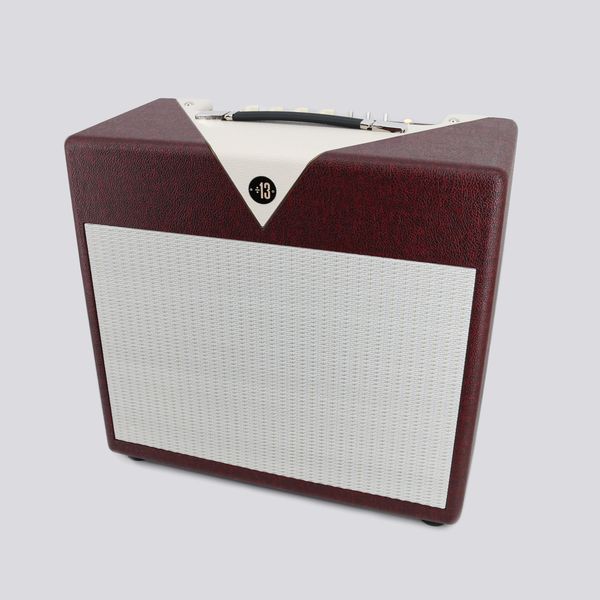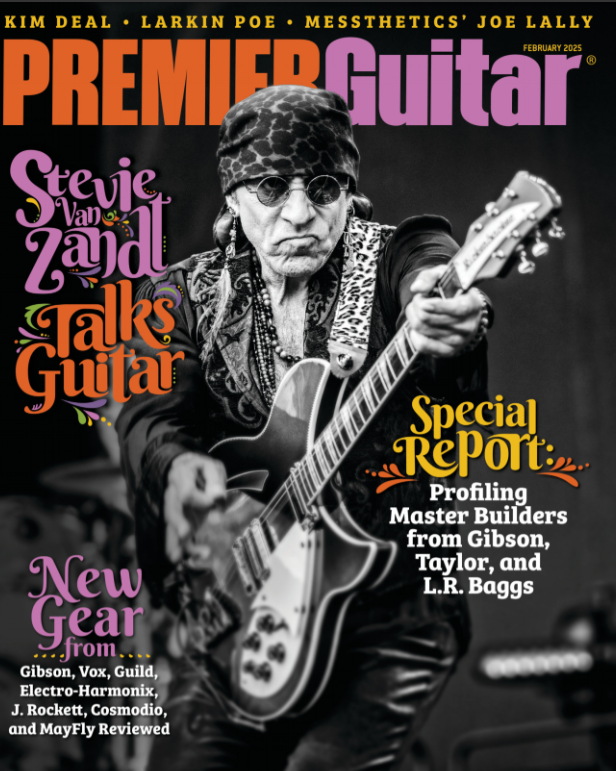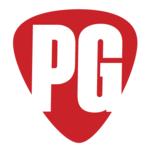
For their new record, Judas Priest turned back the clock to time warp some of their ’70s prog-metal spirit into 2024.
On their new album, Judas Priest brandish an Invincible Shield of righteous heavy metal.
When people talk about Judas Priest, the band’s biggest hits easily spring to mind, and rightfully so. “Breaking the Law,” “Living After Midnight,” “Heading Out to the Highway,” and “You’ve Got Another Thing Comin’” were the songs that made the iconic British metal band a household name in the ’80s. But long before such MTV-friendly anthems catapulted them into superstardom, and more recently, earned them a nod from the Rock and Roll Hall of Fame in the Musical Excellence category, Judas Priest cut a more progressive rug.
Their ’70s-era albums, like Stained Class and Sin After Sin (the latter featuring session drummer extraordinaire Simon Phillips), are masterworks of early progressive metal. Songs like “Victim of Changes,” “Sinner,” and “Beyond the Realms of Death” exude a stylistic depth and structural breadth that was mostly shed during their ’80s heyday. The rhythms—bass and drums in particular—were more adventurous, and the arrangements more intricate. It’s a style of music that would subsequently evolve through bands like Iron Maiden, Dream Theater, and others who have since come to define and expand the genre.
On their new album Invincible Shield, Judas Priest is retrieving a bit of that musical heritage. “I said a long time ago, when we were writing these songs, that they came out a bit more progressive,” says lead guitarist Richie Faulkner. “It’s not progressive like Dream Theater or Rush, but there are a few more twists and turns musically.” Indeed, the songs on Invincible Shield are definitely more complex than one might expect from the band, with many of the arrangements more akin to their ’70s period than the following decade’s crowd-pleasers. Songs like “Panic Attack” and “Trial By Fire” are either built around, or feature significantly, odd-time riffs, a far cry from the 4/4 time signatures Judas Priest built their global success around. Throw in a heaping cup of Screaming for Vengeance-era ferocity in terms of delivery on songs like “Gates of Hell” and “Crown of Horns,” and you have the basic ingredients of Invincible Shield. Bass player Ian Hill, who has been going through the set list for the upcoming tour, is also connecting the musical dots to past works. “The things I’m running through, like ‘Victim of Changes,’ ‘Sinner,’ and ‘The Sentinel,’ are all in the same mold,” the bassist explains. “There are lots of different parts—light and shade—it’s not just all one thing or another. And Invincible Shield is very much like that.”
Judas Priest - Crown of Horns
Originally formed in Birmingham, England, in 1969, Judas Priest has been through an unusually long list of lineup changes, with the core of the band evolving to include guitarists K.K. Downing and Glenn Tipton, bassist Ian Hill, and singer Rob Halford by the release of their debut LP, Rocka Rolla, in 1974. A revolving cast of drummers, including Les Binks and the aforementioned Phillips, mostly ended when Dave Holland joined in 1979, occupying the position for 10 years. Following his departure, Scott Travis joined and has been with the band ever since. Downing left the band in 2011, replaced by Faulkner. Tipton remains an official member of Judas Priest, but his touring activities have been limited since 2018 due to Parkinson’s disease, with Firepower and Invincible Shield producer Andy Sneap filling in for him on the road.
“There are lots of different parts—light and shade—it’s not just all one thing or another.” —Ian Hill
The elements of early Judas Priest’s sound, including Halford’s operatic vocal style and the twin-guitar power of Downing and Tipton, forged a template that would help define the heavy metal genre. Their 1977 release Sin After Sin was their first under a major label, and the first of 10 consecutive records to be certified Gold or Platinum. Then, 1980’s British Steel brought them notable mainstream attention with hits “Breaking the Law” and “Living After Midnight.” A decline in exposure during the mid 1990s, coinciding with Halford leaving and being replaced by Tim “Ripper” Owens, seems a distant memory, as the 2000s saw the band once again become a major force within the metal community. They were inaugural inductees into the VH1 Rock Honors in 2006, received a Grammy Award for Best Metal Performance in 2010, and had their songs featured in popular video games such as Guitar Hero and Rock Band. 2018’s Firepower was the highest-charting album of the band’s career, and in 2022, Judas Priest were finally inducted into the Rock and Roll Hall of Fame.
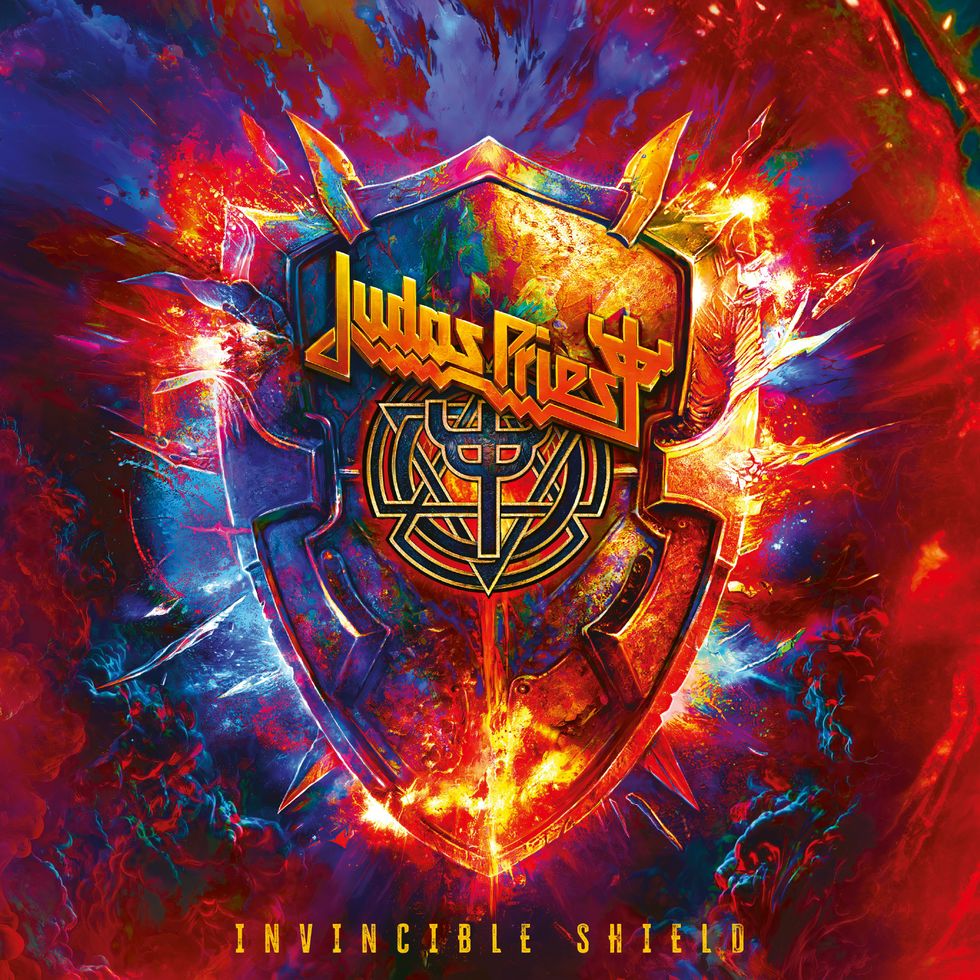
Judas Priest caused quite a stir online when they announced the title and artwork for their 19th studio record, but Richie Faulkner says it’ll all make sense in the end.
Priest’s musical renaissance on Invincible Shield certainly adds greater dimension to their signature sound, but it isn’t really about taking a trip down memory lane. The nod to the past is mostly tangential. The real impetus was wanting to scratch a particular collective itch. “It’s a question of, ‘What can we do different? How can we make this more satisfying as a piece of art?’ If that doesn’t sound too pompous,” explains Faulkner. “You want to challenge yourself and you want to build upon what you’ve done already.”
“It’s a question of, ‘What can we do different? How can we make this more satisfying as a piece of art?’” —Richie Faulkner
Priest has never really been a band to repeat themselves too often. Yes, they’ve followed trends and exhausted songwriting formulas, but they’ve always adapted to changing times and band members. Between Andy Sneap’s fiery, modern production, Faulkner’s youthful and aggressive influence, and the underlying DNA—four of the guys in the band have been there for decades—Judas Priest pull off a pretty compelling hat trick on Invincible Shield. “You want to do something that’s going to be challenging, but also satisfying to us as creative people, and hopefully ticks the boxes for the fans as well,” says Faulkner.
There was, however, a bit of backlash from fans on social media over the album’s title and artwork when it was first announced—commenters felt it was boring and “cheesy”—but Faulkner says context will hopefully bring it all together. “I saw the comments,” he says. “I don’t stick my head in the sand. It’s heavy metal, it’s the shield that we all fly proudly and get behind, and it’s the thing that binds us together.” When the name, the artwork, and ultimately the music all come together, it will make sense, he says.
Glenn Tipton's Gear
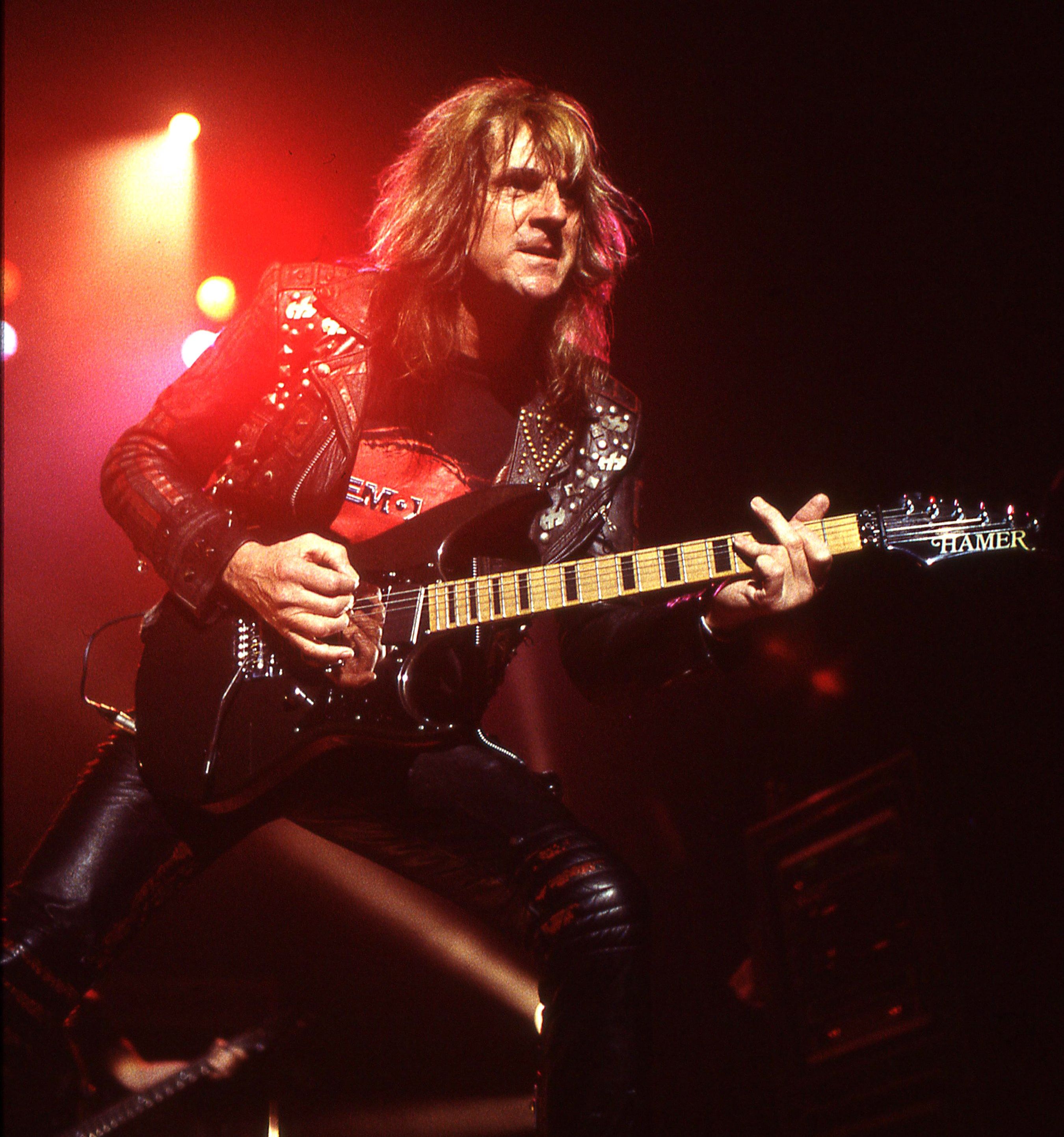
Illness has forced veteran lead guitarist Glenn Tipton, pictured here in 2001, to step back slightly from his duties in Judas Priest, but it didn’t stop him from shredding on Invincible Shield.
Photo by Frank White
Guitars
- ESP GT-600 Signature Model with Glenn Tipton Signature EMG GT Vengeance Pickup Set
- Hamer Phantom GT Signature Model
Amps
- Engl Invader II E642II
- Engl E412VGB 4x12
Effects
- dbx 166A 2-Channel Compressor/Limiter
- DOD FX40B Equalizer
- Dunlop DCR-2SR Cry Baby Rack Module
- Mike Hill Services A-B Both Amp Switcher
- Rocktron Intellifex 24-Bit Digital Effects Processor
- Yamaha SPX90II Digital Multi-Effects Processor
Strings & Picks
- Ernie Ball Custom Gauge (.009–.038)
- Ernie Ball .46 mm picks
With Tipton sidelined and Downing out of the fold for more than a decade now, much of the writing and recording on Invincible Shield fell on Faulkner’s shoulders. Tipton is still contributing from the bench, but it’s Faulkner’s show now. When asked about the musical direction on Invincible Shield, Tipton adds, “It is definitely a case of Richie joining the writing team with his own individual ideas and going at it from slightly different angles.”
“It’s a question of, ‘What can we do different? How can we make this more satisfying as a piece of art?’” —Richie Faulkner
One noticeable difference wrought by those writing angles is the standout performance on Invincible Shield from Ian Hill. Though he’s been historically overlooked in the annals of great metal bassists, Hill has been the foundation of Judas Priest from the beginning, and is, in fact, the band’s only full-time original member. On Invincible Shield, he proves to be more than a root-note-pumping low-ender. Songs like “Panic Attack,” “The Serpent and the King,” and “Giants in the Sky” feature what Hill would call “busy bass work.” There are a lot of unison riffs between the bass and guitars, more along the lines of what you might expect from Iron Maiden, for example, or Stained Class Priest, even. Yet Hill’s approach remains simply focused on the songs. “I’ve always not done much more than what’s necessary,” he explains. “If you’re putting too much on it, you’re actually detracting from the song. This time around, the songs are busier and called for a little more movement.”
Richie Faulkner's Gear
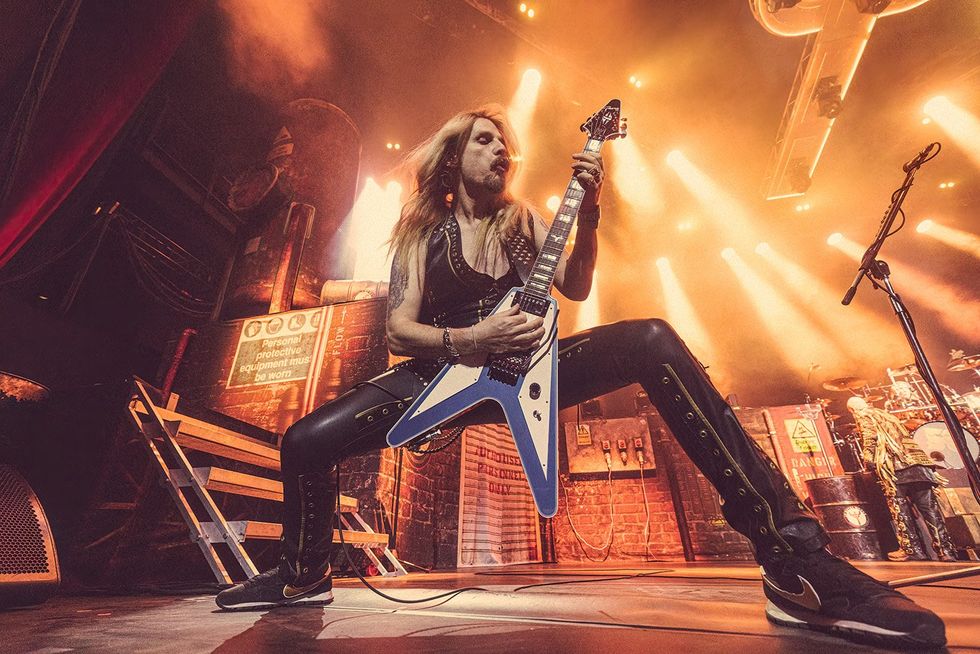
Richie Faulkner has been a member of Priest since 2011, but he still gets nervous showing song ideas to his bandmates.
Photo by Tim Bugbee
Guitars
- Gibson Flying V Signature Custom with Richie Faulkner Signature EMG 57/66 Pickup Set
- Gibson Custom Shop Flying V with Floyd Rose
- Gibson Custom Shop Flying V
- Gibson Custom Shop Explorer
- 1983 Gibson Les Paul Custom
- 1976 Gibson Les Paul Custom
Amps
- Marshall JCM800 2203
- Wizard Modern Classic II
- Wizard GCL 4x12 with Celestion G12H-150 Redback speakers
Effects
- Boss DD-7 Digital Delay
- Boss SL-2 Slicer
- Dunlop JC95B Jerry Cantrell Signature Rainer Fog Cry Baby Wah
- Dunlop JD4S Rotovibe Chorus/Vibrato
- Dunlop DCR-2SR Cry Baby Rack Module
- MXR Micro Chorus
- Wampler Tumnus Deluxe
- Wizard Gate Minder
- RJM Music Technology Effect Gizmo Audio Loop Switcher
- Voodoo Lab Pedal Power 2 Plus
Strings & Picks
Unlike Firepower, an album they had the luxury of recording together, Invincible Shield was done remotely, largely due to the pandemic. “The bare bones of these songs have been around since 2020, just before the lockdowns happened,” recalls Faulkner. After the lockdowns were lifted, the band went back out on the road for their 50th Anniversary tour, and scheduling conflicts ensued. Not to be deterred, and with enough experience to know there’s never a perfect time to do something, the band decided they were going to record the new album however they could, rather than wait for the perfect moment. “Sometimes you just have to do what you can do with the tools that you have,” says Faulkner. “So, I recorded the guitars in my studio at home. The drums were recorded in Nashville, and Rob’s vocals in Phoenix.” Hill actually put most of his bass lines down in hotel rooms on the last tour. “Andy is with us anyway, and he’s got his laptop,” Hill explains. “And you get these days off where you’re sitting around doing nothing, so we figured we might as well be productive. It was a great way to do it, just me and Andy. You’ve got another pair of eyes and you can try different things for the same part.”
“I’ve always not done much more than what’s necessary.” —Ian Hill
Invincible Shield is also a testament to how technology has revolutionized the process of making records, even for Rock and Roll Hall of Fame inductees. Faulkner tracked his guitars at home using the Neural DSP Quad Cortex on a Marshall plexi-like setting. He then sent Sneap that sound along with a clean DI, so he could reamp it. “I think it was a Marshall JCM800 that he used. It’s a new combination—I’m joking,” he laughs, citing the holy grail of rock guitar amps. Faulkner says Sneap also put some gain boost in the front. “He’s a fan of the EVH 5150III and he had some plexis that he was using as well, so I’m not sure how he blended them, but that’s what he usually uses.”
Ian Hill's Gear
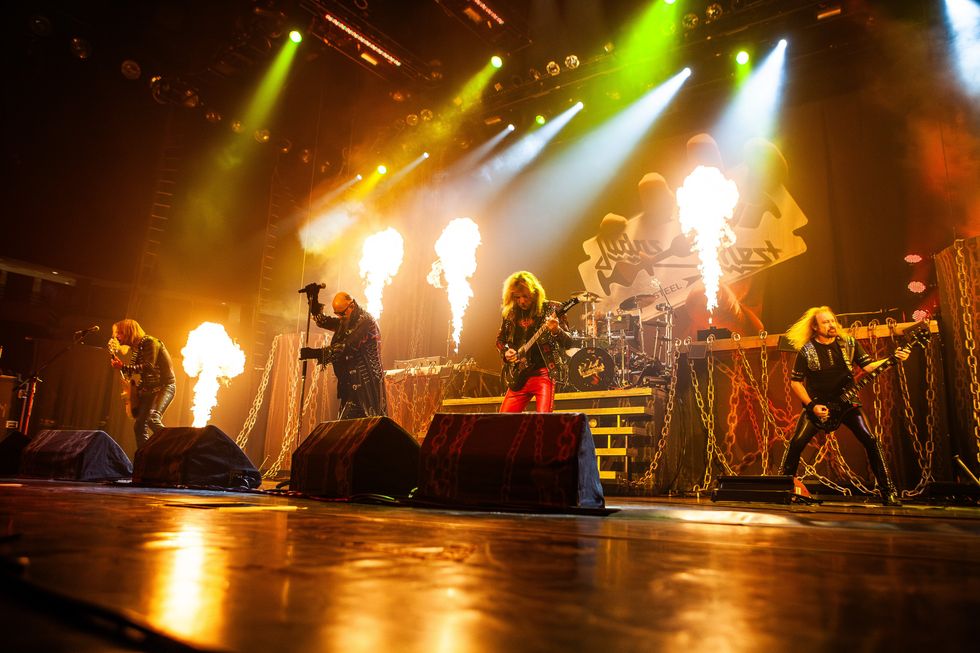
This year mark’s Judas Priest’s 55th year as a band, but they’re still chasing artistic and musical goals. “There’s always a challenge in making art,” says Faulkner, “and that’s what makes it special.”
Photo by Tim Bugbee
Basses
- Four Spector Limited Edition Euro4 Ian Hill basses, two tuned to D#–G#–C#–F#, and two tuned to A#–D#–G#–C#
Amps
- SWR SM-1500
- SWR Triad 3-Way Bass Speaker System
Effects
- Boss ME-50B Bass Multiple Effects
- Boss NS-2 Noise Suppressor
- Mike Hill Services ABCD Guitar Switcher
- Mike Hill Services Earth Loop - Ground Hum Eliminator
- Shure AD4D Two-Channel Digital Wireless Receiver
Strings & Picks
- DR Black Beauties BKB-50 K3 Black Coated Bass Strings
- Dunlop Nylon Standard .73 mm picks
- Signature InTune plectrums
Tipton says the rhythm guitars are put down to create a certain sound throughout the album, but for lead breaks, they will try anything to create the sound they want. “I’ll tweak [my sound] with different mikes and effects,” he explains. “Andy is very good with shaping the guitar sounds, and he knows what he needs to do to get it to sound like Priest.” The bass runs clean, direct to a laptop via an interface. Hill says this has been his approach for some time. “You need a clean bass sound—one that cuts through the two distorted guitars,” he says. “Anything that needs to be changed, or any effect that needs to go on, is put on afterwards.”
As for the actual songwriting process, Tipton says it remains more or less the same, whereby he, Halford, and Faulkner all produce ideas separately then pool them together. But Faulkner has a slightly more nuanced take on the songwriting process, one that you might expect from someone who grew up a fan of the band.
“It’s heavy metal, it’s the shield that we all fly proudly and get behind, and it’s the thing that binds us together.” —Richie Faulkner
“It’s the scariest thing,” he admits. “Let’s say you take fifteen ideas, they’re not complete—they’re just ideas that you think are winners. Then, it’s your turn to put your stuff on and show the room. You think it’s good, but then you put it on in front of Glenn Tipton and Rob Halford, you’re thinking, ‘Oh my god, what have I done here?’ Because all of a sudden, all your stuff sounds like shit,” he laughs. “I think that’s just the insecurities, and then you realize, they put ideas forward and they’re thinking the same thing.” One of the things Faulkner appreciates about this process is that it challenges him to think differently about his own ideas. “Glenn might say, ‘Turn that bit around,’ or ‘Change the feel in that bit.’ And then I do it and it’s like, ‘Ah, that’s actually unique. I wouldn’t have thought of that.’ And that’s when having three creative minds in the room makes the end result a lot better.”
When it comes to crafting and tracking his guitar solos, Faulkner says about 75 percent of it is improvised. “We press record and let it rip,” he explains. “You do that three or four times and a couple of things become constant, subconsciously, and they stick, and so you build around that.” There are a few songs he worked out before recording, including “Panic Attack,” “Invincible Shield,” and “As God Is My Witness.”
“It’s your turn to put your stuff on and show the room. You think it’s good, but then you put it on in front of Glenn Tipton and Rob Halford, you’re thinking, ‘Oh my god, what have I done here?’” —Richie Faulkner
Circling back around to the way Invincible Shield was pieced together remotely, Faulkner says there are always challenges when you record music. “Whether it’s Jaws and the shark is not working, or it’s our situation, there’s always a challenge in making art and that’s what makes it special,” he says. “The challenge for us was getting Invincible Shield to sound cohesive while recording it separately. By overcoming those challenges, it arms you for the next one, and you do it again and hopefully grow.”
YouTube It
At their 2022 Rock and Roll Hall of Fame induction, Judas Priest unleashed a three-guitar attack with K.K. Downing, Glenn Tipton, and Richie Faulkner.
- Judas Priest Announce New Album 'Invincible Shield' ›
- Hooked: Devin Townsend on Judas Priest's "The Sentinel" ›
- Rig Rundown: Judas Priest ›
- Discover Judas Priest's Guitarmony & Sick Riffs - Premier Guitar ›
- Judas Priest Guitarist Richie Faulkner Opens Up About Mental Health Struggles - Premier Guitar ›
- Judas Priest and Alice Cooper Unite for Co-Headlining Fall Tour - Premier Guitar ›
A live editor and browser for customizing Tone Models and presets.
IK Multimedia is pleased to release the TONEX Editor, a free update for TONEX Pedal and TONEX ONE users, available today through the IK Product Manager. This standalone application organizes the hardware library and enables real-time edits to Tone Models and presets with a connected TONEX pedal.
You can access your complete TONEX library, including Tone Models, presets and ToneNET, quickly load favorites to audition, and save to a designated hardware slot on IK hardware pedals. This easy-to-use application simplifies workflow, providing a streamlined experience for preparing TONEX pedals for the stage.
Fine-tune and organize your pedal presets in real time for playing live. Fully compatible with all your previous TONEX library settings and presets. Complete control over all pedal preset parameters, including Global setups. Access all Tone Models/IRs in the hardware memory, computer library, and ToneNET Export/Import entire libraries at once to back up and prepare for gigs Redesigned GUI with adaptive resize saves time and screen space Instantly audition any computer Tone Model or preset through the pedal.
Studio to Stage
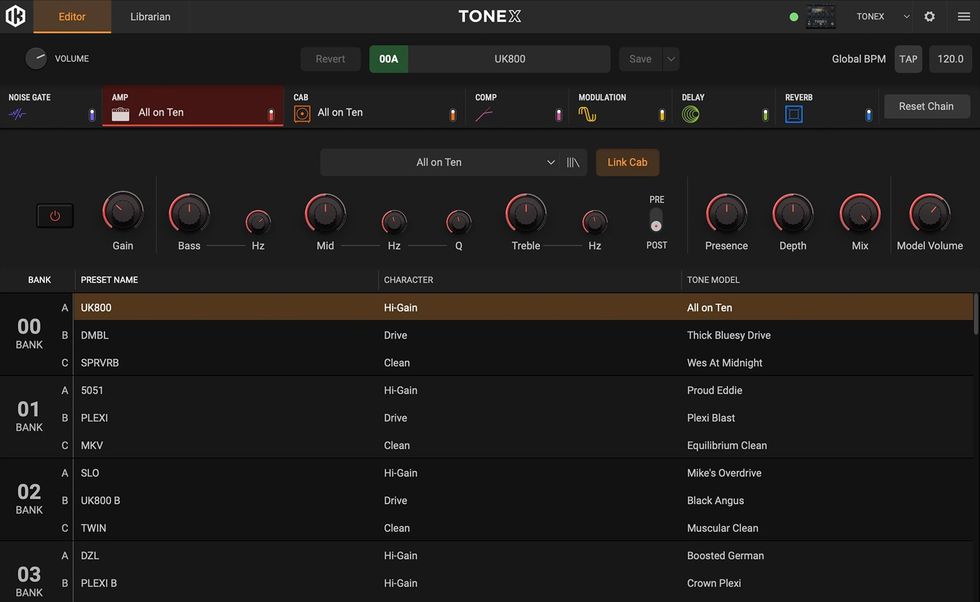
Edit any onboard Tone Model or preset while hearing changes instantly through the pedal. Save new settings directly to the pedal, including global setup and performance modes (TONEX ONE), making it easy to fine-tune and customize your sound. The updated editor features a new floating window design for better screen organization and seamless browsing of Tone Models, amps, cabs, custom IRs and VIR. You can directly access Tone Models and IRs stored in the hardware memory and computer library, streamlining workflow.
A straightforward drop-down menu provides quick access to hardware-stored Tone Models conveniently sorted by type and character. Additionally, the editor offers complete control over all key parameters, including FX, Tone Model Amps, Tone Model Cabs/IR/VIR, and tempo and global setup options, delivering comprehensive, real-time control over all settings.
A Seamless Ecosystem of Tones
TONEX Editor automatically syncs with the entire TONEX user library within the Librarian tab. It provides quick access to all Tone Models, presets and ToneNET, with advanced filtering and folder organization for easy navigation. At the same time, a dedicated auto-load button lets you preview any Tone Model or preset in a designated hardware slot before committing changes.This streamlined workflow ensures quick edits, precise adjustments and the ultimate flexibility in sculpting your tone.
Get Started Today
TONEX Editor is included with TONEX 1.9.0, which was released today. Download or update the TONEX Mac/PC software from the IK Product Manager to install it. Then, launch TONEX Editor from your applications folder or Explorer.
For more information and videos about TONEX Editor, TONEX Pedal, TONEX ONE, and TONEX Cab, visit:
www.ikmultimedia.com/tonexeditor
Two Iconic Titans of Rock & Metal Join Forces for a Can’t-Miss North American Trek
Tickets Available Starting Wednesday, April 16 with Artist Presales
General On Sale Begins Friday, April 18 at 10AM Local on LiveNation.com
This fall, shock rock legend Alice Cooper and heavy metal trailblazers Judas Priest will share the stage for an epic co-headlining tour across North America. Produced by Live Nation, the 22-city run kicks off September 16 at Mississippi Coast Coliseum in Biloxi, MS, and stops in Toronto, Phoenix, Los Angeles, and more before wrapping October 26 at The Cynthia Woods Mitchell Pavilion in The Woodlands, TX.
Coming off the second leg of their Invincible Shield Tour and the release of their celebrated 19th studio album, Judas Priest remains a dominant force in metal. Meanwhile, Alice Cooper, the godfather of theatrical rock, wraps up his "Too Close For Comfort" tour this summer, promoting his most recent "Road" album, and will have an as-yet-unnamed all-new show for this tour. Corrosion of Conformity will join as support on select dates.
Tickets will be available starting Wednesday, April 16 at 10AM local time with Artist Presales. Additional presales will run throughout the week ahead of the general onsale beginning Friday, April 18 at 10AM local time at LiveNation.comTOUR DATES:
Tue Sep 16 – Biloxi, MS – Mississippi Coast Coliseum
Thu Sep 18 – Alpharetta, GA – Ameris Bank Amphitheatre*
Sat Sep 20 – Charlotte, NC – PNC Music Pavilion
Sun Sep 21 – Franklin, TN – FirstBank Amphitheater
Wed Sep 24 – Virginia Beach, VA – Veterans United Home Loans Amphitheater
Fri Sep 26 – Holmdel, NJ – PNC Bank Arts Center
Sat Sep 27 – Saratoga Springs, NY – Broadview Stage at SPAC
Mon Sep 29 – Toronto, ON – Budweiser Stage
Wed Oct 01 – Burgettstown, PA – The Pavilion at Star Lake
Thu Oct 02 – Clarkston, MI – Pine Knob Music Theatre
Sat Oct 04 – Cincinnati, OH – Riverbend Music Center
Sun Oct 05 – Tinley Park, IL – Credit Union 1 Amphitheatre
Fri Oct 10 – Colorado Springs, CO – Broadmoor World Arena
Sun Oct 12 – Salt Lake City, UT – Utah First Credit Union Amphitheatre
Tue Oct 14 – Mountain View, CA – Shoreline Amphitheatre
Wed Oct 15 – Wheatland, CA – Toyota Amphitheatre
Sat Oct 18 – Chula Vista, CA – North Island Credit Union Amphitheatre
Sun Oct 19 – Los Angeles, CA – Kia Forum
Wed Oct 22 – Phoenix, AZ – Talking Stick Resort Amphitheatre
Thu Oct 23 – Albuquerque, NM – Isleta Amphitheater
Sat Oct 25 – Austin, TX – Germania Insurance Amphitheater
Sun Oct 26 – Houston, TX – The Cynthia Woods Mitchell Pavilion
*Without support from Corrosion of Conformity
MT 15 and Archon 50 Classic amplifiers offer fresh tones in release alongside a doubled-in-size Archon cabinet
PRS Guitars today released the updated MT 15 and the new Archon Classic amplifiers, along with a larger Archon speaker cabinet. The 15-watt, two-channel Mark Tremonti signature amp MT 15 now features a lead channel overdrive control. An addition to the Archon series, not a replacement, the 50-watt Classic offers a fresh voice by producing retro rock “classic” tones reminiscent of sound permeating the radio four and five decades ago. Now twice the size of the first Archon cabinet, the Archon 4x12 boasts four Celestion V-Type speakers.
MT 15 Amplifier Head
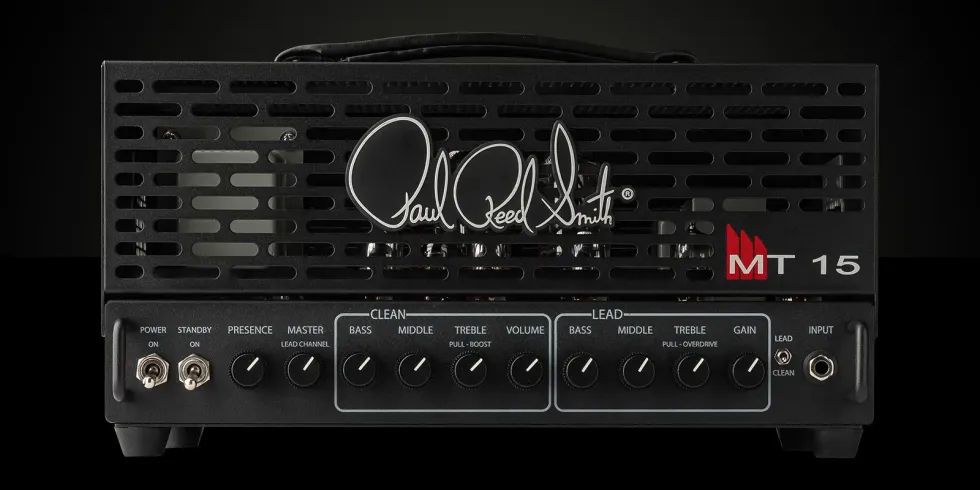
Balancing aggression and articulation, this 15-watt amp supplies both heavy rhythms and clear lead tones. The MT 15 revision builds off the design of the MT 100, bringing the voice of the 100’s overdrive channel into its smaller-format sibling. Updating the model, the lead channel also features a push/pull overdrive control that removes two gain stages to produce vintage, crunchier “mid gain” tones. The clean channel still features a push/pull boost control that adds a touch of overdrive crunch. A half-power switch takes the MT to 7 watts.
“Seven years ago, we released my signature MT 15 amplifier, a compact powerhouse that quickly became a go-to for players seeking both pristine cleans and crushing high-gain tones. In 2023, we took things even further with the MT 100, delivering a full-scale amplifier that carried my signature sound to the next level. That inspired us to find a way to fit the 100's third channel into the 15's lunchbox size,” said Mark Tremonti.
“Today, I’m beyond excited to introduce the next evolution of the MT15, now featuring a push/pull overdrive control on the Lead channel and a half-power switch, giving players even more tonal flexibility to shape their sound with a compact amp. Can’t wait for you all to plug in and experience it!”
Archon Classic Amplifier Head
With a refined gain structure from the original Archon, the Archon Classic’s lead channel offers a wider range of tones colored with gain, especially in the midrange. The clean channel goes from pristine all the way to the edge of breakup. This additional Archon version was developed to be a go-to tool for playing classic rock or pushing the envelope into modern territory. The Archon Classic still features the original’s bright switch, presence and depth controls. PRS continues to stock the Archon in retailers worldwide.
“The Archon Classic is not a re-issue of the original Archon, but a newly voiced circuit with the lead channel excelling in '70s and '80s rock tones and a hotter clean channel able to go into breakup. This is the answer for those wanting an Archon with a hotrod vintage lead channel gain structure without changing preamp tube types, and a juiced- up clean channel without having to use a boost pedal, all wrapped up in a retro-inspired cabinet design,” said PRS Amp Designer Doug Sewell.
Archon 4x12 Cabinet
As in the Archon 1x12 and 2x12, the mega-sized PRS Archon 4x12 speaker cabinet features Celestion V-Type speakers and a closed-back design, delivering power, punch, and tight low end. Also like its smaller brethren, the 4x12 is wrapped in durable black vinyl and adorned with a British-style black knitted-weave grill cloth. The Archon 4x12 is only the second four-speaker cabinet in the PRS lineup, next to the HDRX 4x12.
PRS Guitars continues its schedule of launching new products each month in 2025. Stay tuned to see new gear and 40 th Anniversary limited-edition guitars throughout the year. For all of the latest news, click www.prsguitars.com/40 and follow @prsguitars on Instagram, Tik Tok, Facebook, X, and YouTube.
For two decades, Clapton's Choice Signature Strings have delivered the legendary tone Eric Clapton relies on every time he picks up an acoustic guitar. To celebrate this milestone, Martin Guitar is introducing limited-edition 20th anniversary packaging for these fan-favorite strings--available now through March 2026.

Every limited-edition pack also gives players a chance to win a Martin 000-EC 30th Anniversary guitar--a beautifully crafted instrument with a retail value of $4,999, inspired by the Martin guitars Eric played during his legendary MTV Unplugged performance. The guitar will be awarded to one lucky winner who finds a special ticket inside a pack of strings.
Fans can also enter a second-chance giveaway online for more opportunities to win exclusive prizes, including a Martin guitar strap, poster, collectible lanyard with three custom patches, or even a year's supply of strings.This contest is open to U.S. residents only and ends March 31, 2026. No purchase necessary.
Enter now and learn more at martinguitar.com/eric-clapton-giveaway.
The anniversary release also coincides with the upcoming arrival of Unplugged: Enhanced Edition on vinyl and CD, available May 9. The iconic installment of the MTV Unplugged series--and the greatest-selling live album of all time--returns over 30 years later in an all-new extended, remixed, and remastered version. Featuring never-before-heard commentary from Eric recorded just before the original 1992 performance, the release offers fresh insight into the inspiration behind the songs and includes tracks not featured in the original MTV airing.

Crafted from 92/8 phosphor bronze, Clapton’s Choice Signature Strings are known for their warm, rich tone, smooth feel, and long-lasting performance. They're the same strings Eric uses in the studio and on stage--including during his current eight-night residency at the Nippon Budokan in Tokyo--and he calls them "the sound that I demand."
Whether you're chasing Eric's iconic tone or simply looking for strings that deliver great sound and playability, now is the perfect time to pick up a pack--available in a music store near you or online at
martinguitar.com--and celebrate two decades of signature sound.


